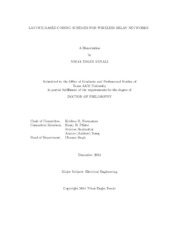| dc.contributor.advisor | Narayanan, Krishna R | |
| dc.creator | Tunali, Nihat Engin | |
| dc.date.accessioned | 2015-04-28T15:36:56Z | |
| dc.date.available | 2016-12-01T06:36:03Z | |
| dc.date.created | 2014-12 | |
| dc.date.issued | 2014-12-10 | |
| dc.date.submitted | December 2014 | |
| dc.identifier.uri | https://hdl.handle.net/1969.1/154157 | |
| dc.description.abstract | Compute-and-forward is a novel relaying paradigm in wireless communications in which relays in a network directly compute or decode functions of signals transmitted from multiple transmitters and forward them to a central destination. In this dissertation, we study three problems related to compute-and-forward.
In the first problem, we consider the use of lattice codes for implementing a compute-and-forward protocol in wireless networks when channel state information is not available at the transmitter. We propose the use of lattice codes over Eisenstein integers and we prove the existence of a sequence of lattices over Eisenstein integers which are good for quantization and achieve capacity over an additive white Gaussian noise (AWGN) channel. Using this, we show that the information rates achievable with nested lattice codebooks over Eisenstein integers are higher than those achievable with nested lattice codebooks over integers considered by Nazer and Gastpar in [6] in the average sense. We also propose a separation-based framework for compute-and-forward that is based on the concatenation of a non-binary linear code with a modulation scheme derived from the ring of Eisenstein integers, which enables the coding gain and shaping gain to be separated, resulting in significantly higher theoretically achievable computation rates.
In the second problem, we construct lattices based on spatially-coupled low-density parity check (LDPC) codes and empirically show that such lattices can approach the Poltyrev limit very closely for the point-to-point unconstrained AWGN channel. We then employ these lattices to implement a compute-and-forward protocol and empirically show that these lattices can approach the theoretically achievable rates closely.
In the third problem, we present a new coding scheme based on concatenating a newly introduced class of lattice codes called convolutional lattice codes with LDPC codes, which we refer to as concatenated convolutional lattice codes (CCLS) and study their application to compute-and-forward (CF). The decoding algorithm for CCLC is based on an appropriate combination of the stack decoder with a message passing algorithm, and is computationally much more efficient than the conventional decoding algorithm for convolutional lattice codes. Simulation results show that CCLC can approach the point-to-point uniform input AWGN capacity very closely with soft decision decoding. Also, we show that they possess the required algebraic structure which makes them suitable for recovering linear combinations (over a finite field) of the transmitted signals in a multiple access channel. This facilitates their use as a coding scheme for the compute-and-forward paradigm. Simulation results show that CCLC can approach theoretically achievable rates very closely when implemented for the compute-and-forward. | en |
| dc.format.mimetype | application/pdf | |
| dc.language.iso | en | |
| dc.subject | Physical layer network coding | en |
| dc.subject | lattices | en |
| dc.title | Lattice-Based Coding Schemes for Wireless Relay Networks | en |
| dc.type | Thesis | en |
| thesis.degree.department | Electrical and Computer Engineering | en |
| thesis.degree.discipline | Electrical Engineering | en |
| thesis.degree.grantor | Texas A & M University | en |
| thesis.degree.name | Doctor of Philosophy | en |
| thesis.degree.level | Doctoral | en |
| dc.contributor.committeeMember | Pfister, Henry D | |
| dc.contributor.committeeMember | Shakkottai, Srinivas | |
| dc.contributor.committeeMember | Jiang, Anxiao | |
| dc.type.material | text | en |
| dc.date.updated | 2015-04-28T15:36:56Z | |
| local.embargo.terms | 2016-12-01 | |
| local.etdauthor.orcid | 0000-0002-3367-826X | |


